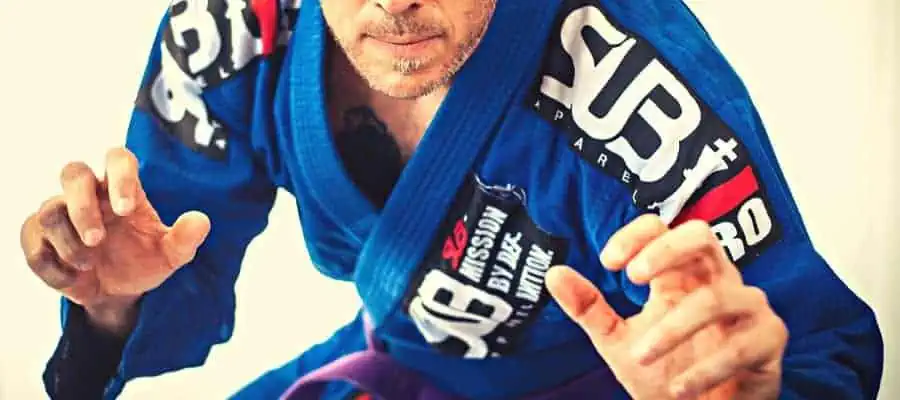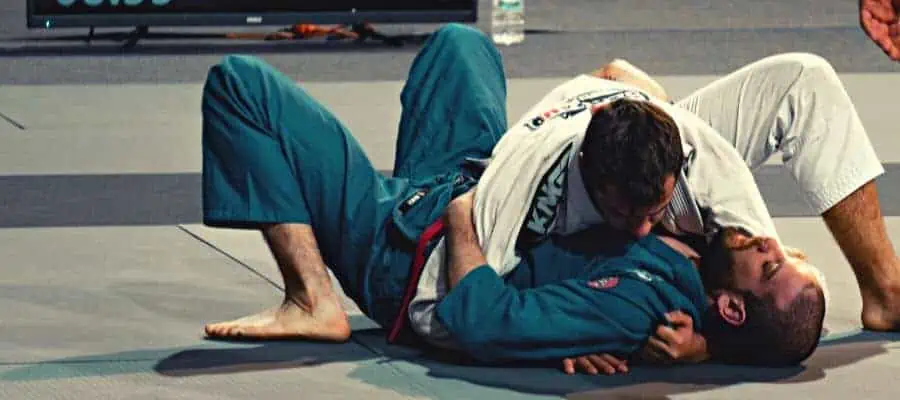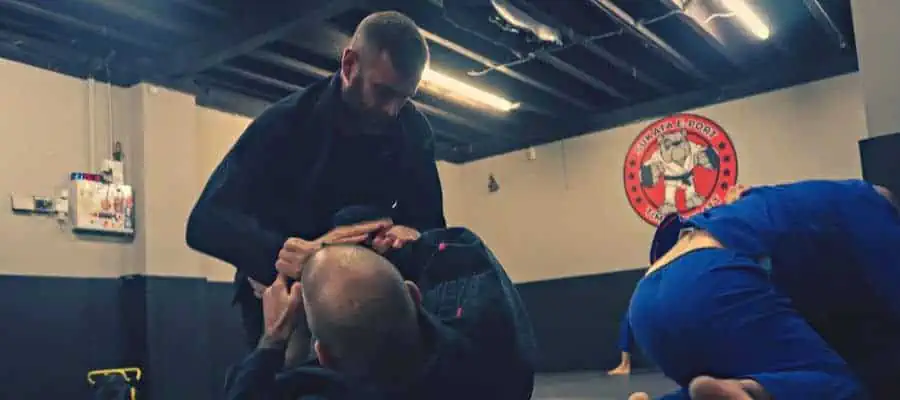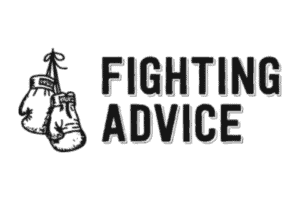A phenomenon that started with basketball and volleyball has spread to many other sports, including BJJ. Not all athletes do it, but it’s pretty common to see a fighter with taped fingers. Taping can limit the range of movement of the fingers and might reduce grip efficiency. But there’s a point in it.
So why do BJJ Fighters Tape Their Fingers? Injuries to the fingers may happen in the BJJ practice. Many fighters tape their fingers to prevent them from happening or avoid an existing injury from getting worse. In the long term, it’s not cheap. But a severe injury would be a much higher price to pay.
A slight limitation to movement might look like a minor issue, but it’s not. In a high-level competition, details are decisive. Nevertheless, sometimes it’s essential to limit movement. There are moments at which any movement can make things worse.
Does Taping The Fingers Prevent Injuries?

Taping is a technique used to prevent injuries and prevent them from getting worse. Fighters must not underestimate the effects of a finger injury.
The Relevance Of Finger Injuries
According to a 2017 research, about 15% of all injuries during BJJ practice affect the fingers. The second highest prevalence stays under 11% – foot and toes. In a sport that is forbidden to attack this part of the body, that’s a scary number. This means that all injuries to the fingers are accidental.
You won’t find a single BJJ fighter who has never hurt one of his fingers. The incidence of these injuries is much higher in gi than in no-gi practice. Besides its abrasiveness, the gi can get a finger stuck and be the cause of torsion or compression. These injuries are not a BJJ fighter’s worst nightmare, though.
They don’t usually prevent an athlete from training or fighting. But that doesn’t mean that the pain won’t restrict his actions. There is a saying in the fighting world that states that “no athlete ever fights at 100%”. There is always, at least, a slight injury or condition as a result of high-level training. But, if you can avoid it, you should.
Fighting with an injury must be an issue. First, resting is essential for recovering. An injury can become much worse with effort. Sometimes, what was a minor problem might turn into a matter of surgery. At best, it will take more time for a fighter to come back to the game. Worst case scenario: it might take him out of the sport altogether.
The Psychological Effects Of An Injury
We can’t also ignore the impaired performance due to the lack of confidence generated by the injury. An athlete who gets his arm strained in an arm bar might tap faster the next time. Trauma is a real thing in Martial Arts. Some fighters never get back to their old self after a severe injury.
Nick Chewy Albin broke his nose in 2014 in an accident during BJJ practice. He was already a BJJ black belt, and it took him a long time to get back to sparring again. Today, as the leader of Derby City Mixed Martial Arts, he says he had to develop a strategy to come back. First, he started to train with more experienced guys, who he was sure would not hurt him. Then, he slowly got back to train with the others.
Even a living legend such as Anderson Silva is not immune to the ghosts of an injury. After breaking his leg against Chris Weidman, the Spider went to many therapy sessions to be able to kick again.
But there are a few fighters who were never the same again after a severe injury. This is the case for Thiago “Marreta” Santos, Rashad Evans, and Quinton “Rampage” Jackson. They were all ascending among the best fighters in the world when they got hurt. Their decline started just after their injuries.
A fighter can and must use everything in his reach to prevent injuries. It means physiotherapy, strengthening, stretching, legal drugs and supplements, and gear. If it works, it must be a tool.
Does Taping The Fingers Really Work?
This is not a BJJ thing. As mentioned, it began with basketball and volleyball many years ago. Finger injuries are very relevant in these sports. But you can also see taped fingers among climbers, goalkeepers, Judokas, Wrestlers, and many others.
Let’s rip this bandage out: there is no research proving the effectiveness of this method in injury prevention. In fact, this is a poorly researched subject. Some people will defend taping as a required method to prevent injuries. Others will label it as entirely useless.
However, it does have some logic. Almost half of the reported finger injuries in BJJ are composed of hyperextensions. Taping might cushion a blow that would otherwise result in a severe injury. It’s just mechanics.
Restricting movement is also the basics of rehabilitation of injuries, such as strains. If resting is not an option, taping might be. But to be effective, athletes must do it right. There are three main methods of finger taping, and they serve different purposes.
How To Tape Your Fingers

In the Martial Arts world, athletes use three methods to tape their fingers.
X Taping
The “x taping” connects two phalanges through two lines that make an “x” on the joint. The goal is to reduce the probability of hyperextension. The mechanic protection, what is saying the tape resistance, might be one more obstacle to the injury. This method limits grip efficiency when used as prevention. Whether it’s worth it depends on the risk of injury and how much it affects performance.
Buddy Taping
The “buddy taping” is a more simple method. It consists of splinting two fingers together. Its goal is to prevent the most significant injury to this part of the body: jammed fingers. A jammed finger is when the tip of the finger is compressed towards the hand.
It might affect nerves and ligaments or even result in a fracture. Fighters must do the buddy taping at two different heights to be effective. This method is also used after an injury. It helps in the recovery because it limits the movement of a finger through the tenacity of another.
Restrictive Taping
The “restrictive taping” is a method used as an emergency action to keep the athlete on the game. It consists of taping the joints to reduce the impact on an already injured area. When used after an injury, taping supposedly prevents a sprained finger’s worsening. Athletes can use any method above, but some seem to be more effective by their very definition.
Limiting movement seems to reduce grip effectiveness. But taping might also be a method of increasing strength in the crimp grip position after an injury. This is what a paper published in the Journal of Applied Biomechanics in 2007 states. This means that, after the injury, restraining movement increases grip efficiency.
According to scientists, a taping method known as “H-tape” could increase strength in this position by 13% after an injury. This method is quite similar to the X taping used by BJJ fighters. It consists in making an H with the tape, connecting two phalanges.
However, it’s essential to observe that, in the mentioned research, 13% is a value still inside the error bar. Fighters must not completely discard this, though. Although there are some promising results after an injury, there is no research until this moment about the potential to prevent them.
What Kind Of Tape Should You Use?

There are many tapes available in the market. Today, there are even some brands specific for BJJ athletes. But you don’t need to spend a lot of money on something expensive just because a brand has used a different stamp from the traditional ones.
A good tape should be firm, non-elastic, and highly adhesive. It must be water-resistant too, so sweating will not change its properties. A specific brand can be much more expensive, but some have advantages compared to classic tapes.
“PowerTrain” is a well-known brand that makes tapes for grappling sports. It claims to have a technology that repels water. This way, it doesn’t let the tape lose its aggressive adhesive even under the most grueling, moist condition. Besides, it has a size that doesn’t require the tape to be cut before applying.
Gold BJJ is another brand that promises the same as “PowerTrain.” In addition, they state that their strong adhesive doesn’t leave any residue behind. This brand also has a subscription option that reduces cost with time.
But among the most famous brands, Hampton Adams is the one that has the best evaluation on Amazon. The only feature that seems to differ is its “Second Skin Technology” adhesive compared to the others. It keeps the tape in place without any irritating gummy residue left behind, and it’s easy to remove.
Although all of them have advantages compared to the classic type, these tapes are much more expensive.
Does Taping Worth The Money Spent?

Although there is no research confirming the efficiency of taping, its principle does make sense. The cost of doing it once is irrelevant. But as a method for day-to-day training, it might be an issue.
Taking the USA market as an example, a 5 meters x 2 inches roll of tape costs about $10. Athletes could make something between 35 and 40 tapings with just one tape. Depending on the method and the fingers taped, this could mean from 10 to 20 sessions of BJJ per tape roll. People usually train from amateur to professional athletes from 2 to 10 sessions a week.
In conclusion, in the worst-case scenario, taping would cost about $10 a week. You might believe this is too much but think twice. The typical cost of non-surgical treatment of a finger dislocation or fracture goes from $360 to $479. This does not include the doctor fee, which is usually one of the highest costs of any treatment.
Surgical treatment can reach more than $6.000. These are costs for procedures in Nebraska at the Saint Elizabeth Regional Medical Center in 2021. Put, even a simple treatment will cost over $500. This is almost 50 weeks of taping. So it can be easily more than a year. And this is just considering the direct cost.
You must consider some other costs. Losing even a week of training is not something irrelevant. At the highest level of competition, this could be a disaster. So, imagine yourself having a surgery that you could prevent. The estimated time to heal from a finger surgery is about six weeks.
Any time away from training and fighting for a professional athlete also means less money. Leo Elias, currently one of the most outstanding Muay Thai trainers in the world, once said:
“you can’t recklessly put some western fighters to train in Thailand. I mean, these guys come trying to prove they are better than the Thai. It’s not that they are bad people, they are just trying to prove themselves. But there are other ways to do it. Sparring is different from fighting. You can’t use all your power or someone will get hurt. A Muay Thai athlete fights once, twice a month. BJJ and MMA are not that different when you’re trying to rise in a career.
So, not being able to fight for a while due to an injury is tragic. They provide for themselves, for their families, by fighting. No fight, no money. They can’t afford to have an injury. This is the reason why sparring in Thailand is so technical. In most western gyms is somewhat crazy. They spar as if they were fighting. It’s impossible to have a long and successful career like that”.
Although he talked mainly about Muay Thai, you can easily translate this knowledge to BJJ. Professional athletes must keep fighting, or they won’t make money. Injuries happen, but it’s essential to avoid them.
Conclusion
It’s hard to advocate in favor of something you are not sure works. But, by empiricism, it looks like it does. For this reason, most BJJ fighters keep taping their fingers. It certainly has a cost, but any injury would make you understand that it’s better to be safe than sorry. You must choose your tape well. But, nowadays, this is not a problem anymore. There are plenty of options, even some specific for grappling.
Recent Posts
What is Manachai's Fighting Style? Unveiling Muay Thai Mastery
Manachai, a celebrated figure in the Muay Thai world, has captivated audiences with his exemplary martial prowess. Hailing from the heartlands of Thailand, his name is synonymous with the art of...
What Was Chamuekpet Hapalang's Fighting Style? Unveiling Techniques
Chamuekpet Hapalang was a renowned figure in the world of Muay Thai (record 200-48-2), embodying a fusion of Muay Bouk and Muay Khao styles. Originating from Thailand, the art of Muay Thai is known...
